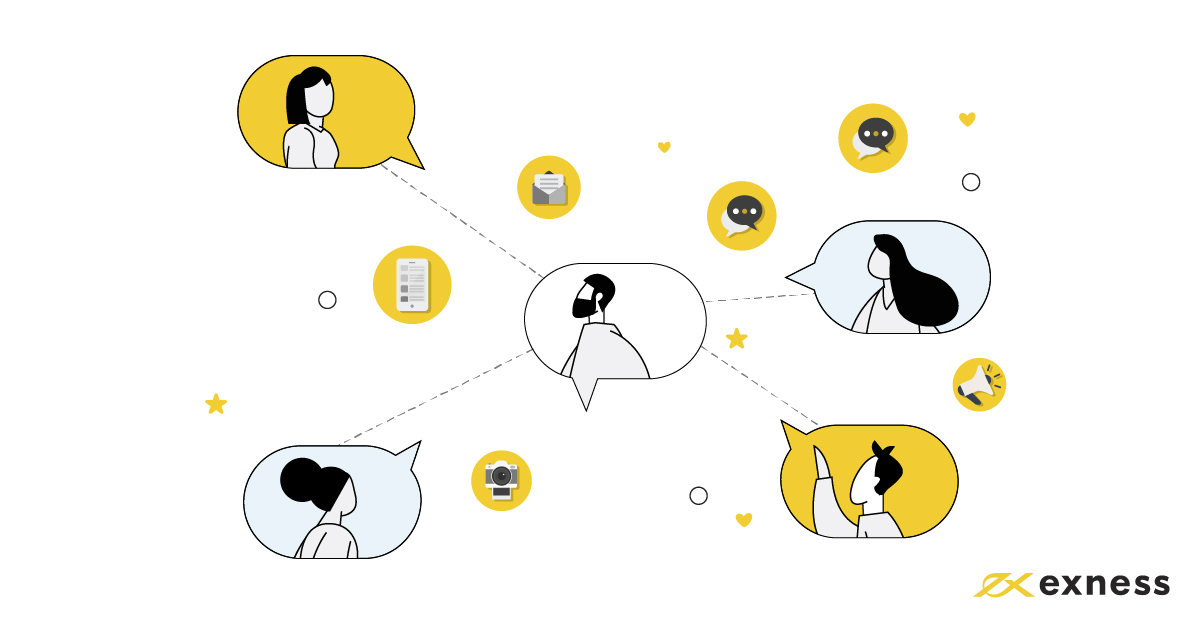It seems that not so long ago I talked about how exchange of knowledge in Exness looks like through the eyes of a beginner, and now again there is something to tell!
In fact, flexibility and speed are two big benefits in any business. And this affects the work of a knowledge manager to a huge extent.
Today I will tell you about three simple, but very popular activities in the company. I would like to note that it took a little more than a month on the way from idea to implementation, and, probably, this should say a lot about corporate culture.
Why would you like to share this here on Habré? Quite simply: In the IT world, knowledge management is still considered to be difficult, requiring a lot of effort and thought. Many times I heard something like: “Well, this is all long and incomprehensible. Is it possible somehow quickly and simply? "
So, simple tools that any company can use in their work, regardless of whether you have a knowledge management manager or you are a startup with three developers.

In our company, no one learns anything in time ...
A popular situation, agree. I have heard stories about how support learns about new features from customers. Why it happens? Usually because internal communications in the company work organically (as it turns out) or to communicate using means that are inconvenient for most of the company. For example, developers prefer to plan projects and releases in JIRA and do not even think that people from sales or technical support are not following their JIRA projects. Or internal communications employees believe that the corporate portal they created is the most heavenly place in the world, and everyone reads the mailing lists.
But this is not the case. In fact, it is convenient for each department and even each person to receive information from different channels. Someone can follow the news on a corporate social network without loss of productivity, while someone does not even sit on ordinary social networks. Someone reads all the notifications from JIRA that are sent to him in the mail, while someone considers them unnecessary noise and honestly says that he does not even open them. Some people like to discuss everything at personal meetings, while others only by correspondence.
All people are different, therefore, the more diverse information delivery channels you launch, the more people in the company will be able to receive information in a convenient way. This means that, with a high degree of probability, they will learn about innovations earlier than customers :)
The main thing is that the information is the same everywhere, and the channels work with a certain regularity, and not randomly.
Whoever really needs it will find out anyway!
A popular but flawed approach that can lead to problems. Of course, there are always very proactive people who find out about a new feature when you haven't even planned a release date yet. But still such a minority. And in a fairly introverted IT, their number tends to zero.
But that's not the point. People are not required to follow your projects and decisions. You are responsible for them, you know when everything is ready for launch, you determine the release date. So what is the difficulty in telling interested people about this?
Moreover, there are situations when you know better who is affected by the planned update. And if a person does not even suspect that you are preparing something that can change his business as usual, how should he predict your actions?
It seems to me that everyone can imagine what silence leads to. Customer complaints, lengthening project deadlines, poor productivity, inconsistent solutions, duplication of functions and activities in different teams, and many other things that management usually don't like. And all this can be avoided very simply: start talking about what you have done or are planning to do.
If you do not have a department that deals with the transfer of knowledge within the company (knowledge management or internal communications), you need to (in the sense of must) do it on your own. If there is such a department (I am very happy for you!), Then you need to transfer the information to it in time, and colleagues themselves will spread it in the best way.
It's all long and difficult. It's better to cut features faster!
In IT, I often come across the opinion that sharing knowledge is all long and difficult, that it greatly distracts from the most important (the product will not write itself!). That is why knowledge activities often do not even start. Or, after starting on a wave of enthusiasm, when the initiators are faced with the need to sell their idea to everyone and everyone, the motivation fades, and the transfer of knowledge stops.
In fact, it's not all that difficult. You don't need to invent any fancy systems. It is enough just to see what you already use in the company in order to share knowledge and communicate, and just start systematic informing colleagues through these channels.
For example, you have an internal mail in your company. Who is stopping you from just starting once a month to send a newsletter to the entire company with a description of what your team has done this month? If you have no time to write large texts, you can simply limit yourself to a short description like “We optimized process A” and add a link to the task in the tracker.
Of course, you won't be able to enter the market without a working product. Nobody diminishes the importance of development. But once a month export a list of tasks from JIRA, add 3-5 words to each description, copy it into an email and press the "Send" button, it won't take long, right? Yes, you and so, most likely, something like this for the leadership, compose and send.
Well, or count how much time you spend on explaining to each questioner about the same question? For example, how does your library work there? I'm not sure that if you add up the time of all your responses, it will be less than the time it takes to create that very new feature. It is quite possible that you talk many times longer than you work on a product.
Where should i write? What to use?
Of course, communication channels can be different. What to use depends on the culture of your particular company. If you have accepted Slack chats and mail, create a separate news channel and monthly digest using email newsletters. The most important thing to remember and understand is that people are different and they prefer to receive information in different ways. Also, people do not use services that are inconvenient for them. Even if the boss forces.
Therefore, you cannot expect that your newsletter will be read by 100% of colleagues who need information, and a chat in Slack will not be on Mute for half of the audience. This means that you need to create as many communication channels as possible. As we say "to sound from each iron." Then there are some chances to reach out to each employee, provide him with information in the way he is ready to receive it.
How convenient is it for you to follow the news? Someone likes tapes, someone listens to the radio in the car, someone watches a video, and someone just in the cafeteria learns everything from colleagues.
In conditions of remoteness, digital means of transmitting information are generally very helpful. For example, personally, being in the constant process of sharing knowledge, I practically do not feel that I am sitting at home, in a completely different country, and have never drank coffee with my colleagues.
So what are you doing yourself?
The more options are involved, the greater the chance that the entire company lives with the same data. This is what drives us in developing knowledge management at Exness.
In the last article I talked about how all the information received is recorded in the knowledge base and announced in a special public on the internal social network. In July, we added three new ways to reach the ears and eyes of the audience at once. I'll tell you about each as much as possible. However, in principle, all our initiatives are very simple solutions available to any company.

Knowledge Base Blog and Blog Yellow Pages
Everyone knows that every Confluence space has an entity called a Blog? How many of you use it?
In fact, the blog is good. It allows you to create posts that are ranked by freshness (the freshest is the topmost). However, the link to the blog remains unchanged. That is, when opening a blog of a specific space, a visitor will always see the latest news. At the same time, the old ones don't go anywhere - they just go down.
You can subscribe to the blog. Then, for each new post, you will receive a notification in the mail.
At the same time, each blog post remains at the same time a separate page in Confluence, which can be linked to, which can be opened and edited separately, tagged as needed.
Based on the results of a survey of employees, we found out that it is not convenient for everyone to follow the internal social network. However, everyone knows about the existence of the Knowledge Base. And we began to duplicate all the news that is published on the social network into the blog. Is it inconvenient to follow posts in different chats and groups? Please subscribe to the blog and receive news notifications in the mail.
By the way, about tagging. It is clear that employees are not interested in all news. Someone needs to know what's going on in marketing, while someone only needs updates on a specific product. It is quite difficult to separate the necessary news from the blog feed on your own. However, another standard Confluence functionality allows you to pull posts from a blog to any page, according to the labels used (Labels).
To make it convenient for everyone, we divided all the news that we broadcast by topics, assigned labels to each topic and set up the section structure on a separate page. In each of the sections, news on the relevant topic (based on labels) for the last 60 days is pulled from the blog.
We called this resource Blog Yellow Pages, and now any employee interested in a specific topic can come in and see the latest news on the business area or product of interest.
We could not have limited the limitation period for posts, but the company's business is changing very quickly and the lists would otherwise become too long. And this leads to problems with the usability of the service.
In general, as you can see, nothing complicated. Out-of-the-box Confluence features, 30 seconds to copy the news from the social network, paste it into the blog editor and mark it with the necessary labels. But this is not only a social network, which is not convenient for everyone to follow.
Monthly email digest

What could be easier than corporate mail? Of course, I know at least one large company in which mail does not exist at all. But this is an exception. And for most companies, mail is such a natural means of communication that it’s even surprising why they don’t use it to spread news.
There was little use of mail at Exness. Probably it happened historically. But no one interfered (and is not interfering now) with us working on reviving it.
Smart people say that even if a resource is unfamiliar, but contains important, valuable for the employee and visually appealing (= professionally designed) content, readers will use it, and you will receive positive feedback.
However, even if the channel does not take off, you can refuse to use it further for free.
In general, again, for those who are uncomfortable using the social network, in July we made the first mail news digest for the past month.
We have collected in one letter the most important changes for July, supplemented them with small descriptions (as far as I remember, these are called "leads"), added direct links to announcements and sent it out to the entire company through a marketing mailing service.
Why not just a personal email, like mine? I never tire of saying that PR and marketing are very important components of knowledge management. It is impossible without them. This means that you need to use analytics, study the behavior of your customers, count conversions, create logos for your activities, etc.
In our case, we wanted to see how many people generally read mail in the company, and what news they themselves considered important (we filled out the mailing list based on our own understanding of the importance of news).
That is, two important values for us that the marketing mailing service allows us to receive are: a) the number of unique recipients who opened the mailing list, and b) the number of clicks from the mailing list for each of the links.
I was glad to see that, despite all the talk that the company had more mail for any notifications, over two-thirds of the employees read the mailing list. And many of them also followed the links. So it makes sense in the mail digest.
This is also proven by the fact that after the mailing list, product managers began to approach me and ask if news about their products could be included in the letter? But this is not about an external client service, but about colleagues, company employees. It would seem that whoever wants to will know everything anyway (read above). But no. In the last article I already wrote that the company is aware of the importance of streamlined knowledge exchange. So the initiative comes not only from knowledge managers and technical support, but also, in fact, from experts, carriers and producers of knowledge.
Online meetings with experts

There is a lot of talk about the culture of internal meetups in the community now. That you need to launch them, you need to share knowledge, train public speaking, arrange various FuckUp Nights and other useful offline events.
But how to do this in a remote location? How to make sure that the expert's speech does not turn into Yet Another Webinar with a talking head and a poorly prepared presentation.
Well, since during meetups people usually exchange knowledge (rummage around, answer questions), then it is the knowledge manager who needs to think about it.
Personally, I am very driven by internal meetups, workshops from employees, train the trainer and other similar events. During them, you can extract from the expert as much useful and important information, moreover, directly, without intermediaries, as never happens in mail correspondence or through documentation. Here he is, the man in front of you. You can ask him any question right here, and he will answer you right now.
Having a need in the company to understand our various products, we decided to organize a project called Live Updates. This is not really a webinar. And not so much a webinar as a full-fledged mini-conference in Zoom using the Slido online survey platform.
In the first part, we again go through important news with the help of the knowledge management team. This takes about 20 minutes. Our speakers are company trainers who, on a weekly basis, conduct company-wide seminars dedicated to news and changes. They know and are able to convey and chew information. Therefore, despite the fact that the news has already been delivered through several channels, this part does not become a boring repetition (well, you remember, "so that it sounds from every iron").
In general, pedagogical design experts say that repetition of information is never superfluous, and any information must be periodically re-delivered to the trainees in order for it to be consolidated. Better yet, back it up with practice. Which we did. After the part with the news, we prepared a quiz for all the news, which requires not only to select the information that has already been sounded, but also to apply some kind of logic to solve the situation from the question. The quiz winner gets a little memento from the company, which I think is nice.
After the news review, a special guest appears on the air. This is the head of some product team who prepares for the event a small (also 20 minutes) review of his product, trends, features, results and everything that he wants to convey to the audience, and then answers all the questions that the audience has in live broadcast.
Questions and preparation of the presentation should be discussed separately. We are interested in the quality of the speech (the speaker, by the way, too). Therefore, we are working on it together. In about a week, a room for an event is created in Slido, and access to the room is broadcast over standard channels (remember: social network, chats, digest, blog). Anyone can anonymously (or not) leave their question and like strangers. We open up access to questions for the speaker so that he can understand what interests the audience the most and unfold his presentation accordingly. Or not to expand, but simply to prepare in advance the answers to these questions.
A couple of days before the event, we run a run-through of the speaker with the speaker, check the technical side of the broadcast, give feedback on the content, the manner of speaking (online and offline are two big differences) and remove questions from Slido that will be covered in the presentation.
During the performance, we continue to collect questions from the audience. Why isn't it done by voice or Zoom chat? Slido solves two problems at once.
First, you can start collecting questions ahead of time and do it anonymously. This is important because many people are afraid and embarrassed to ask questions in person, and even out loud. There are several reasons for this, psychologists talk a lot about them, I will leave this topic outside the article. Just point out to yourself that being able to ask questions anonymously removes this barrier.
Why encourage shy listeners to ask questions? They do not ask, so it’s not so necessary ... Believe me, it’s not so. And this can lead to serious problems for the company. Imagine that our shy employee is working with a Very Important Client. And he knows that this client has a certain specificity, about which it was not clear or just a little said in his speech. And now our shy employee, who does not have comfortable conditions for asking questions, postpones his question to the last and ... does not have time to ask it, because the event is limited in time.
There is a gap in the knowledge of this employee, and a Very Important Client, as luck would have it, at this very moment asks about this topic. Agree, the risk of losing this client becomes obvious. A shy employee does not know the answer to the question, and the company risks losing money.
The second plus of Slido is convenience. The platform is convenient for both visitors and organizers. It supports any device. The speaker can speak into the camera and manage polls in parallel with the phone. The platform has a convenient admin panel and a beautiful front that you can fumble about on the air.
On the plus side, the platform allows you to conduct surveys during events, which makes them more lively and interactive. And the questions themselves do not lie somewhere in separate Zoom records, all of them can be found in the same admin panel and downloaded in a convenient format.
In general, add interactivity to the events, and it will turn out no worse than offline!
And then what?
If it seems to you that the above is "a lot" and "long", then I will immediately disappoint you. It took one month of hard work in parallel with other tasks to launch all the activities.
And the plans are even more. Our next steps: communities of practice, corporate blog (not the one with the news in Confluence, but quite a real blog for a variety of stories: from participating in competitions and financial results of the company to describing a favorite travel destination), workshops that are professionals in their sphere is held for everyone who wants to understand their profession, and the continuation of the development of the culture of internal meetups in various forms.
What for? So that people in the company get to know each other, talk, argue and thereby develop each other and come up with new ideas for business together.
We don't want a knowledge manager! What to do?
Of course, I understand that not all IT companies are ready to allocate at least one staff unit for a knowledge manager. IT executives usually strive to hire an additional developer whenever possible in order to release features faster (see above why this doesn't work). But in fact, all the activities described above can be realized by the forces of people already in the company. Yes, it will definitely take longer and more painful, but still activities will start and develop, and this is already a lot.
So who can replace your knowledge manager?
First of all, internal communications. As you may have noticed, everything I described above lies in the field of communications, transferring knowledge from experts to departments in need. If you build communication processes between different business units, knowledge exchange will work. Well, since this is about communication, then the intercom (intercom) can quite reasonably do this. For example, I cannot imagine some of the planned activities possible without the participation of an intercom (the same corporate blog).
If you also do not have internal communications, then you can contact the devrels. In principle, this is a fairly unique phenomenon in IT, which is designed to establish communication between IT specialists and with other departments. And the devrels may well be responsible for all these activities.
Well, in the most extreme case, you can blame everything on the team leads. It is much easier and faster to start building communications within your team than on a company-wide basis. And if someone's initiative takes off, they will be able to share their approaches with other teams.
Still, I highly recommend that you consider hiring a knowledge manager (or better than two) so that you don't have to come up with workarounds. This will help any company to know more about itself, which means better planning, inventing and developing.